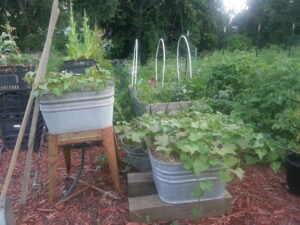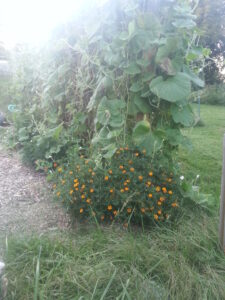2016 Annual Report for FNC16-1065
Growing Produce Vertically instead of Horizontally to get a High Production on a Small Urban Farm
Summary
Overall this year was a great year! We taught over 40 individuals about growing produce in an urban setting. We ourselves learned several things... what we need to do to improve milk crate gardens and who to target for them. We learned a lot more about potato towers and things we will try differently next year. We learned how easy and effective it is to grow up instead of out. Even a 10 lb. squash can be grown up; next year we will be aiming for 20 lbs. on a trellis system. With getting the sample/teaching garden done we will be able to do workshops right at the garden and they will be able to see what it should look like when they are done. We will be able to work with  SARE Grant for Pepper Berries Urban Farm 2individuals on the best way for them to grow produce to bring in extra income by suggesting and helping them build non traditional gardens to get the most produce that they can.
SARE Grant for Pepper Berries Urban Farm 2individuals on the best way for them to grow produce to bring in extra income by suggesting and helping them build non traditional gardens to get the most produce that they can.
Objectives/Performance Targets
Growing Potatoes Growing Potatoes slide show Garden classes Farm to Table Dinner and Workshop
Our objectives was to teach growers/farmers in an urban setting how to grow vertically instead of horizontally. For our first year we accomplished a lot. We started with removing a tree in the center of a 40 x 60 foot area that would be our sample/teaching garden. We build a 25 ft. x 8 ft. wall for vine crops to grow on out of 2x4, post and wire. This is a wall that could easily be built along a garage or house. We only planted 2/3 of it this year and harvested on average 50 lbs. a week of cucuzza squash. We also built a trellis system using cattle fencing and t post 8x8. We grew cushaw squash on this, we let then get to 10 lbs. this year, next year we will let some of them mature to 20 lbs. and see how they do growing up the trellis. We also had 2 milk crate gardens that were stacked 3 high. One was a strawberry garden the other was grown with greens and a tomato on top. We put in container gardens with sweet potatoes, turmeric and also tomatoes, cucumbers and Swiss Chard. We will be doing the same thing again this year with some modifications. We changed our potato towers from the 2015 year to be smaller and changed the way we grew them this year to see if we could get better yields. This next year we will be doing them both ways plus a third way to see the yields. All of the experiments will be done again plus we will be putting in some of the systems that we didn't get to this year such as "hay bale, 50 gallon containers, gutter gardens and pallet gardens. We will be able to look at all these different methods and compare the results and be able to teach growers/farmers in an urban setting the best methods to use for their growing situation. For our potato towers we are discouraged with the results so far but with the changes that we do next year we are hoping for a great yield on production.
Accomplishments/Milestones
We accomplished so much this year.... The sample/teaching garden was almost completed. We taught 6 classes on gardening in an urban setting, (potato growing, strawberry milk crate towers, milk crate gardens, container gardens). We had a total of 34 participate in them. We also helped 6 growers/farmers build a garden. We provided and help build 4 potato towers in 2016, 2 of the recipients sell produce at Ivanhoe Farmers Market. We provided 1 young family who lived in a duplex with 2 milk crate gardens; 1 was a strawberry tower, 1 was greens and tomato plants. We provided and helped put together a greens garden on a fence and 2 container gardens for a young college man in the inner city who lives in an apartment building. We gave away 3 potato bags and helped 1 person with the dirt and potatoes for the bag.
We had the privilege to speak several times and share our project with many individuals. First we were able to have a booth for free at Santa Calagon Days, 6 blocks from our home. We were there 2 full days from 8 am to 10 pm. We talked and shared our vision with so many who were really interested in how we are trying to help low income growers/farmers in our community. We talked to well over 125 individuals and had 76 sign up for our newsletter that we will start sending out monthly 1/1/17. We also spoke at a SARE workshop that was put on by UMO & Lincoln University. We also were able to speak at a Beginning Homestead Series put on by University of Missouri.
We put in 16 Blackberry plants and put 1 in a container, planted 10 blueberry plants and 1 in a container. We did get 3 grape vines in but still need to plant a container one. We did a lot of companion planting, container planting and traditional planting to measure the results of our project next year.
We had 4 individuals who came out to the farm to help us out and learn how to grow in a small area. One young lady came 2 times a week faithfully from May - August, another one came for 6 weeks and learned how to plant. A young man came out 3 times and learned about maintaining the gardens and harvesting. Another young lady came out and helped plant and harvest one afternoon.
Impacts and Contributions/Outcomes
The impact that we accomplished this year was teaching and helping over 40 individuals to grow where they are in the inner city through classes, workshops and farm work. We also explained to many people at the farmers markets about how to grow something, shared with them our classes and talked to them a lot on growing right where they are. We taught one of the classes at a Senior Apartment complex where we had 15 attend the class. We provided tomato, eggplant, kale, lettuce and pepper plants for them to grow in the milk crate gardens for their patios. With follow up on these individuals and continuing to mentor and instruct these individuals we can expect more produce to be sold at farmers markets, more produce available right out their back doors.